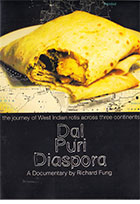
Dal Puri Diaspora 2012
Distributed by Third World Newsreel, 545 Eighth Avenue, Suite 550, New York, NY 10018; 212-947-9277
Directed by Richard Fung
DVD , color, 80 min.
College - General Adult
Cooking, Food, Globalization, Foodways*
Date Entered: 10/28/2016
Reviewed by Andy Horbal, University of Maryland LibrariesWinter makes artist and writer Richard Fung, who was born in Trinidad but now lives in Canada, long for the tropics. When he’s unable to actually go there, he settles for what to him is the next best thing, a delicacy his mother used to make called dal puri. Dal puri (which in Canada is more commonly known as West Indian roti) is a flaky flatbread containing a layer of ground dal (split peas) wrapped around a mixture of curried meats or vegetables. Fung observes that although he loves dal puri and has eaten it hundreds of times, the origins of the dish have always been a mystery to him. To Canadians, dal puri is Caribbean, but in Guyana, Suriname, and Trinidad (the specific Caribbean nations where it’s eaten), it’s considered to be an Indian food. Perplexingly, though, Fung was never able to find in India on any of his several visits there dating back to the 1970s. When none of his Indian friends were able to tell him why not, Fung decided to solve the mystery himself, and so Dal Puri Diaspora was born.
After an introductory scene in Canada, the film moves first to Trinidad, then to India. As Fung follows dal puri backwards in time, he lingers at each step. The Trinidad sequence, for instance, features not just the footage of roti makers plying their trade and visits to masala factories that you would expect to find in a documentary about food, but also interviews with scholars of Trinidadian history who paint a picture of the world to which the immigrants who brought dal puri from India arrived when they came to the new world to work as indentured servants. Fung also isn’t shy about inserting his personal theories and history into the film. He speculates that dal puri must be a commercial creation, since everyday roti is too thin to be wrapped around a filling without tearing, and that commercial spice mixtures had a democratizing influence on Indo-Caribbean cuisine by discouraging the development of regional flavor variations, eliminating the need for women to spend time grinding spices, and making dishes like dal puri accessible even to non-Indian Trinidadians like his mother. The overall effect is to cast Fung in the role of a detective, gathering facts and working slowly but steadily toward his solution.
The film’s climax takes place in India. Having determined that dal puri originally hails from the Bhojpuri region of India, Fung travels to a village in Bihar where he learns that the dish is made exclusively in the home on special occasions (explaining why he never encountered it on his previous visits to India) and meets a woman willing to cook it for him. Tasting it is a revelation, albeit not in the way he expected: because it has been fried in a wok instead of cooked on a griddle, uses wheat flour instead of white flour, and contains different seasonings, the dish tastes dramatically different from what he’s used to, leading him to conclude that the Caribbean version isn’t a copy, but rather is an original in its own right.
The fact that Dal Puri Diaspora doesn’t end here could be considered either a strength or a weakness, depending on what kind of film the viewer wants it to be. The last two reels contain a visit to the African island nation of Mauritius, where dal puri is also eaten; an exploration of the role that roti shops played as community centers for Caribbean immigrants to Canada; and scenes of Fung learning to make roti for himself. The scattershot nature of this section’s content draws attention to the intermittent use of experimental filmmaking techniques such as rotoscoping and inconsistent approach to subtitling (which is sometimes, but not always, used to highlight foreign words, and displays a list of ingredients exactly once) employed throughout the film. While this might be considered a lack of focus in a traditional documentary, it could just as easily be celebrated as representing the sort of idiosyncratic decisions that are the hallmark of autobiographical filmmaking.
The film’s final scene takes place in a Surinamese roti shop in New Delhi that sells dal puri, but under a different name, which the proprietor explains makes it less “scary” to the store’s Indian customers. The roti here is flaky and made with white flour, and the seasonings are the same ones that Fung grew up with. It’s a perfect note to end on: almost 200 years later, dal puri has come home to India as an “ethnic” food. To contemplate its journey is to consider all the ways in which the world has changed during this time, and Dal Puri Diaspora has enormous potential as an instructional tool for the thousands of teachers whose goal is to inspire their students to do just that.
- Awards
- Samsung Audience Award, Toronto Reel Asian International Film Festival
- Best Feature Film, CaribbeanTales International Film Festival